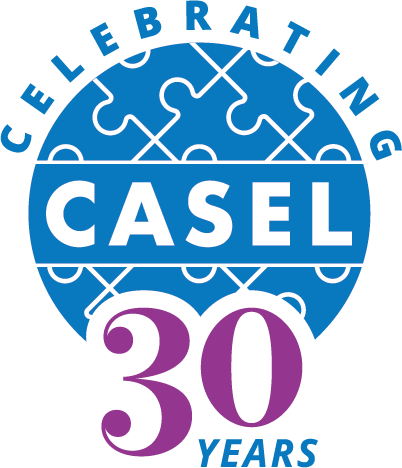The 2017 Cross-District Learning Event was the inaugural convening for the Collaborating Districts Initiative.
The 2017 Cross-Districts Learning Event, held in Oakland, Calif., March 8-10, was the largest to date. Nearly 200 participants representing 18 school districts attended. The theme was “Creating Conditions for SEL through Partnerships, Practices, and Programs.” The three-day conference included a variety of discussions and sessions addressing SEL topics emerging in the districts; a sneak peek at CASEL’s upcoming District Resource Center, an online tool for planning and implementing SEL in districts and schools; and visits to local Oakland schools.
Thanks to the Stuart Foundation and the S. D. Bechtel, Jr. Foundation for generously sponsoring this year’s event.
Tim Shriver keynote: “We’re not throwin’ away our shot”
In his opening night keynote, CASEL Board Chairman Tim Shriver offered four key principles: (1) Focus on evidence of what makes a difference for kids. (2) Focus on the key levers of change to help scale our work. (3) Tell the story so people understand it, believe it, and advocate for it. (4) Continue closing gaps in research and practice. The field is eager to learn more about SEL, Shriver said. He closed by channeling the musical “Hamilton”: “And we’re not throwin’ away our shot.”
Hammond keynote: Culturally Responsive Teaching & The Brain
In a powerful and provocative keynote address Thursday morning, Zaretta Hammond challenged participants to prioritize contextualizing SEL to be responsive to all students. Hammond urged educators to address racial disparities head-on and to avoid “color blindness,” which reinforces the dominant narrative of white privilege and minority inferiority. Strong, trusting relationships are at the center of both SEL and culturally responsive teaching, where “teachers believe that each student brings with them strengths that are rooted in attributes of their learned ‘deep culture.’” It is the teacher’s charge to create trusting environments where each student is respected and nurtured to his or her greatest potential. Hammond highlighted using SEL to help students get through “the learning pit.” SEL creates a high-trust, low-stress environment “so students don’t freak out when learning gets hard,” she said. “Trust gives teachers the permission to help push kids through the learning pit…. You need to get their minds calm enough to do rigorous work.” Otherwise, without a foundation of a trusting relationship, the brain’s amygdala will get “hijacked,” which leads to fear, disengagement, and flight.
Other Highlights
The Power of Partnerships. Peter Brunn, vice president and director of organizational learning and communications, Center for the Collaborative Classroom, gave the opening presentation on the first day. Partnerships, he said, are all about building relationships. The same is true of good teaching.
SEL Practices for Adult Learning. To create optimal conditions for adult learning and social-emotional competence, the Oakland district encourages all meetings and professional learning to follow a set of clear principles.
Creating the Conditions for Student Learning. The Oakland district promotes SEL practices in three main categories to create conditions for growth and learning across all five SEL competencies while using culturally responsive teaching strategies to create harmonious, interdependent, collaborative classrooms.
Assessment in the California CORE Districts. Noah Bookman, chief strategy officer for the eight California CORE districts, shared examples from the extensive student surveys and teacher ratings that the districts field tested in 2015—focused both on SEL and school climate and culture.
Creating “Relationship-Centered Schools”. Tenth-grader Kweko Power shared her first-hand experience of what “relationship-centered schools” look like during a small-group session on equity. “For me, equity means all students get what they need to achieve,” she said. She also shared a short, powerful video and handout from the Californians for Justice Believe in Me Campaign.
The Role of Demonstration Schools as a Catalyst for SEL Implementation. Sonny Kim of the Oakland Unified School District provided insights into how Oakland’s learning hub schools demonstrate what it means to implement schoolwide SEL. Drawing from experiences at Oakland’s three hub schools, Kim led a discussion of the pros and cons of using demonstration schools, noting that for successful implementation, schools must have full buy-in from the principal. Staffing and curriculum planning for SEL are another key to success.
Restorative Justice
David Yusem, who coordinates the Restorative Justice (RJ) program in the Oakland Unified School District, was co-leader of this session with high school student David Contreras. Restorative Justice is about a building a healthy, respectful community, they emphasized. Rather than a program, it’s a philosophical framework for addressing school problems. Central to school-based RJ is the ability to respond to wrong-doing in a positive rather than punitive way. Supported by a network of trainers and facilitators, RJ in the Oakland schools started in the middle schools and is now being practiced in the high schools.
African American Male Achievement. Christopher Chatmon, deputy chief for equity for the Oakland Unified School District, offered a compelling case for changing society’s often negative stereotype of young African-American males. For starters, Chatmon refers to the youth he works with as “Kings.” He has dedicated his life and work to creating pathways to their success.

